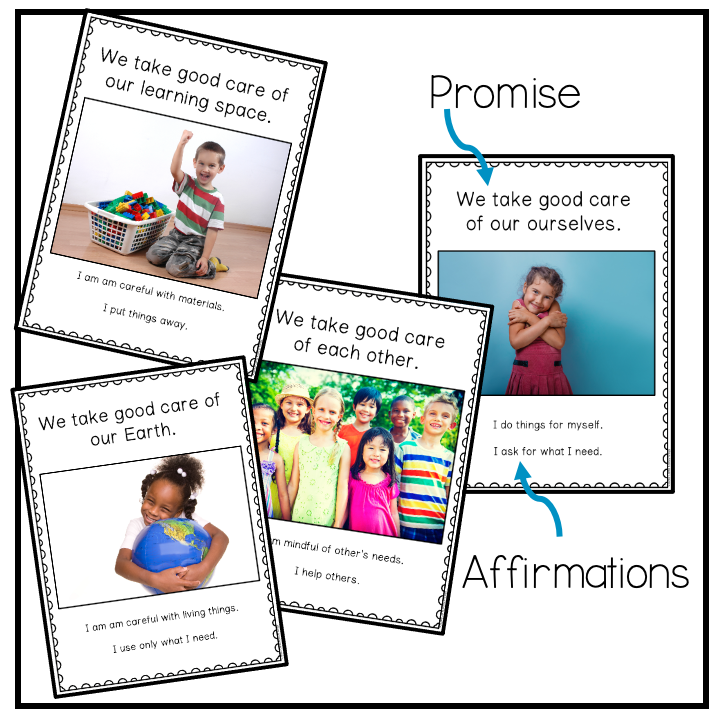Inside: Here I share an inquiry journey, that led to a set of student-created class rules in kindergarten.
It All Started With a Question
At kindergarten orientation, I asked, “What do you want to know about kindergarten?”
There were a lot of typical questions about the bus, lunch, toys, and where they would sit.
And then one boy asked, “Can we do whatever we want?”

Now that was a question I hadn’t heard. And I wasn’t exactly sure how to answer it.
I went home that night and thought about it a bit more. And then I realized that this might be a really good question for us to explore in our first weeks together.
So that’s what we did. And here’s that adventure!
What the Kids Think
Once school had officially started, I asked each child to answer the question, “Can we do whatever we want in school? and prompted them to answer, “yes, because” or “no, because.” I listened and recorded their responses.
I took their answers home that evening and looked them over. Their responses all fell into 4 categories. This framed our journey from that point on:
- No, because we might get hurt or sick.
- No, because our school might get broken or messy.
- No, because we are still learning from right and wrong.
- Yes, because we sometimes have safe choices.

Ask the Experts
Wanting children to see that class rules affected everyone, I invited our school principal, social worker, nurse, and custodian in for a visit. We interviewed each one and asked two questions:
- What kind of work do you do at our school?
- Can we do whatever we want in school?

All the adults gave a different response and helped us explore new ways of understanding the need for class rules in our kindergarten classroom.
Our school custodian explained that there are different rules for different places such as the playground vs. the classroom and what you can do in one place you may not be able to do in another.
Our school social worker, pictured above, answered the question very succinctly, No, because other people matter.(our Positivity Project motto).
Kindergarten Class Rules in Literature
Following the interviews, we explored books such as No David, Little Rabbit Foo Foo, and Five Little Monkeys Jumping on the Bed to read about characters who did whatever they wanted.

As we read and talked, the word “naughty” came up a lot in our conversations. We decided that this meant that someone knows the rules, but chooses not follow them.
We also read, What if Everybody Did That? by Ellen Javernick. This book was super helpful in showing us how to think beyond ourselves.
Student-Created Class Rules in Kindergarten
Once the children began to see the need for rules, I asked them each to name a rule that they thought would be important in school and wrote them down.
One child responded, “Don’t come to school naked” which was definitely influenced by their favorite page in the David books!
I then was able to sort their rules into these three categories:
- We take good care of ourselves.
- We take good care of others.
- We take good care of our learning space.
And if I’m being honest, I didn’t just pull these out of thin air. These were 3 of the 4 class rules that I usually use in kindergarten. I liked the way they were worded and wanted to continue to use them. (You can find the FREE classroom rule posters here).

But the way that we arrived at them this year, was a very different, and much more worthwhile process, than in previous years, where it was much more teacher-directed.
The only class rule that their responses didn’t address was, “We take good care of the Earth.” So, out of respect for the integrity of our inquiry journey, I left that one off, even though it still seemed important to me.
Beyond the Kindergarten Class Rules Inquiry
These three class rules became our “promises,” that we recited at the beginning of each day. More importantly, the words became part of the language that we used with one another.
As one little boy cleaned up a water spill, he said, “I’m taking good care of our learning space!” And I wondered if he would have internalized the language, had he not been so involved in the process of exploring and creating the class rules.
For more ideas on co-creating with children, check out the Student-Centered Classroom Toolkit for practical ways that you can support children in becoming more active and engaged participants in your classroom environment.
And for more stuff on building a classroom culture, check out the Growing a Community category in the Roots & Wings Resource Library.
This post contains affiliate links. Roots & Wings is a participant in the Amazon Services LLC Associates Program, an affiliate advertising program designed to provide a means for sites to earn advertising fees by advertising and linking to Amazon.com.





 Halloween Tap and Write Reader Freebie
Halloween Tap and Write Reader Freebie The Pumpkin Project
The Pumpkin Project Curious Classroom Book Study: Investigate Ourselves and Our Classmates
Curious Classroom Book Study: Investigate Ourselves and Our Classmates Get-to-Know-You Activities for the First Weeks of Kindergarten
Get-to-Know-You Activities for the First Weeks of Kindergarten